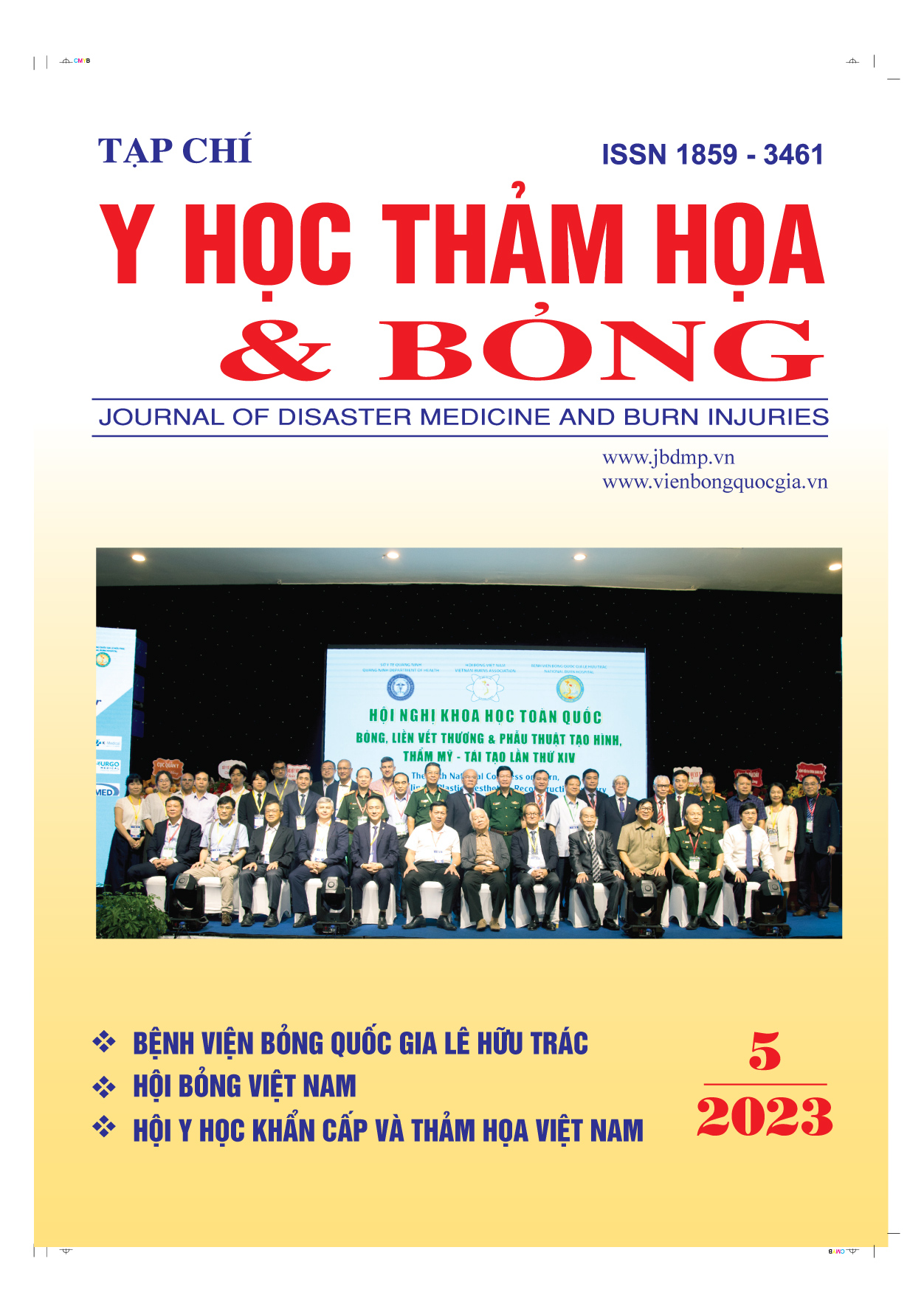Epidemiological clinical and therapy treatment at the Children's Hospital 1
Main Article Content
Abstract
Objectives: In Southern Vietnam, few pediatric burn studies have been reported. Therefore, we researched "Epidemiological, clinical and burn treatment at Children's Hospital 1".
Materials and methods: 383 burned children were treated at the Burns-Plastic Surgery Department of Children's Hospital 1 from February 1, 2021, to August 15, 2022. The research method is descriptive prospective, longitudinal follow-up.
Results: During the study period from February 1, 2021, to August 15, 2022, there were 383 admissions to Children's Hospital 1 recorded mean age of 44.9 ± 46.4 months (02 - 192), of which 73.6% were under 60 months; 55.9% more boys than 44.1% girls; 67.6% had first aid for burns and 14.1% had correct first aid for burns; 96.2% of burns are due to domestic accidents, 77.6% of hot water burns, 10.9% of fire burns, 3.7% of electrical burns and 0.5% of chemical burns. The average burn area was 9.9 ± 11.2% total body surface area (TBSA), the area < 10% TBSA was 67.9%; II-degree burns is 61.9%, II-III degree burns is 37.1%, III-IV degree burns is 1%; burn location 77% of limbs, 56.4% of chest and back, 34.4% of head and neck, 24% of genitals and perineum with. Blood albumin has a very close negative linear correlation with burn area (R = -0.72, p = 0.003), when burn area increases, blood albumin will decrease with the linear regression equation is blood albumin = -0.029 x burn area + 3.416. The causative agent of sepsis with a positive blood culture of 60% is Staphylococcus coagulase negative. The complication rate of 21.9% infection (8.6% burn infection, 6.8% sepsis, 2.3% pneumonia, 1.6% gastrointestinal infection, 0.8% septic shock, 0.5% cellulitis, 0.5% catheter infection, 0.5% central nervous system infections); 3.9% respiratory failure; 2.8% burn shock; 2.3% morphine withdrawal syndrome; 1.8% acute malnutrition; 1.8% gastrointestinal bleeding and 0.3% compartment compression. The mortality rate is 0.3%.
Conclusions: Burns occur more in boys than in girls, the rate of first aid burns is still low, the cause of burns is mainly due to domestic and home accidents, and the main cause of burns is hot water. Treatment of burn shock with albumin in 48 hours after burn according to burn area is 49% TBSA should compensate for shock with albumin, 31% TBSA ≤ burn area < 49% TBSA considering each case and burn area < 31% TBSA with no indication for albumin. The greater the depth of burns, the more cutting and grafting of the burned skin. Complications of burns in children increase as the area increases. Complications of burns in children increase as the depth of burns increases. Child burn mortality in our study was due to respiratory burns and hemorrhagic shock from bleeding in the incision area compressing the cavity.
Article Details
Keywords
Burns children, burn children complications
References
2. Trần Đình Hùng và cộng sự. Nghiên cứu một số đặc điểm bỏng điện ở trẻ em điều trị tại Bệnh viện Bỏng Quốc gia từ tháng 1 năm 2017 đến tháng 12 năm 2019. Tạp chí Y Học Thảm Họa và Bỏng. 2021;3:tr. 21-26.
3. Asena M, Aydin Ozturk P, Ozturk U. Sociodemographic and culture results of pediatric burns. International wound journal. 2020; 17 (1): pp. 132-136.
4. Agbenorku P, Aboah K, Akpaloo J, et al. Epidemiological studies of burn patients in a burn center in Ghana: any clues for prevention? Burns trauma. 2016; 4: pp. 1-4.
5. Brusselaers N, Monstrey S, Vogelaers D, Hoste E, Blot S. Severe burn injury in Europe: a systematic review of the incidence, etiology, morbidity, and mortality. Critical care. 2010;14(5): pp. 1-12.
6. Davies K, Johnson EL, Hollén L, et al. Incidence of medically attended pediatric burns across the UK. Injury Prevention. 2020; 26 (1): pp. 24-30.
7. Dhopte A, Tiwari V, Patel P, Bamal R. Epidemiology of pediatric burns and future prevention strategies - a study of 475 patients from a high-volume burn center in North India. Burns & Trauma. 2017; 5 (1): pp. 1-8.
8. Ekrami A, Hemadi A, Latifi M, Kalantar E. Epidemiology of hospitalized burn patients in Taleghani Hospital during 2003-2007. Bratislavské lekárske listy. 2010; 111 (7): pp.384-388.
9. Morgan M, Deuis JR, Frøsig-Jørgensen M, et al. Burn pain: a systematic and critical review of epidemiology, pathophysiology, and treatment. Pain medicine. 2018;19 (4): pp. 708-734.
10. Keshavarz M, Javanmardi F, Mohammdi AA. A decade epidemiological study of pediatric burns in the southwest of Iran. World journal of plastic surgery. 2020; 9 (1): pp. 67.


